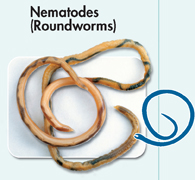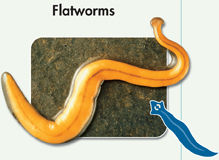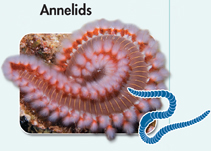| INVERTEBRATE | PHYLUM | DESCRIPTION |
|---|---|---|
| Members of the phylum Arthropoda (ahr THRAHP oh duh) include spiders; centipedes; insects; and crustaceans, such as crabs. Arthron means “joint” in Greek, and podos means “foot.” |
Arthropods have bodies divided into segments, a tough external skeleton called an exoskeleton, cephalization, and jointed appendages. Arthropods appeared in the sea about 600 million years ago and have since colonized freshwater habitats, the land, and the air. At least a million species have been identified—more than three times the number of all other animal species combined! |
|
Members of the phylum Nematoda range in size from microscopic to 1 meter in length. |
Nematodes, or roundworms, are unsegmented worms with pseudocoeloms, specialized tissues and organ systems, and digestive tracts with two openings—a mouth and an anus. Some are free-living and inhabit soil or various aquatic habitats. Others are parasites that infect a wide range of plants and animals, including humans. Nematodes were once thought to be closely related to flatworms, annelids, and mollusks but have been found to be more closely related to arthropods. |
|
The phylum Platyhelminthes (plat ih hel MIN theez) contains the flatworms. |
Flatworms are soft, unsegmented, flattened worms that have tissues and internal organ systems. They are the simplest animals to have three embryonic germ layers, bilateral symmetry, and cephalization. Most flatworms are no more than a few millimeters thick. Flatworms do not have coeloms. |
|
The phylum Annelida (un NEL ih duh) includes earthworms, some exotic-looking marine worms, and parasitic, bloodsucking leeches. |
Annelids are worms with segmented bodies and a true coelom lined with tissue derived from mesoderm. The name Annelida is derived from the Latin annellus, which means “little ring.” The name refers to the ringlike appearance of the body segments of annelids. |
|
Table of Contents
- Formulas and Equations
- Applying Formulas and Equations
- Mean, Median, and Mode
- Estimation
- Using Measurements in Calculations
- Effects of Measurement Errors
- Accuracy
- Precision
- Comparing Accuracy and Precision
- Significant Figures
- Calculating With Significant Figures
- Scientific Notation
- Calculating With Scientific Notation
- Dimensional Analysis
- Applying Dimensional Analysis






 DOL•34–DOL•37
DOL•34–DOL•37
 DOL•38
DOL•38
 DOL•39
DOL•39
 DOL•40–DOL•41
DOL•40–DOL•41